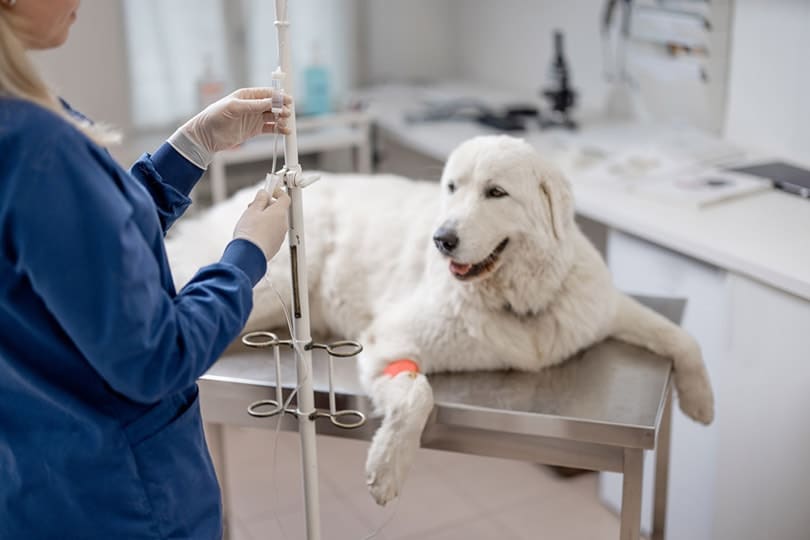Your dog may become sick or injured when your vet clinic is closed and when this happens, you will have to rush your dog to an emergency vet clinic.
Beyond the worry and fear of this kind of visit, sometimes the price is a factor. How much a visit to an emergency vet clinic costs depends on several factors. But as a general overview, the average cost of an emergency vet could be anywhere from $250 to as much as $8,000. Here, we get into what these are and provide you with a range of possible prices that you can expect to pay under those circumstances.
The Importance of Your Dog’s Health
We all want our pets to be in good health for their entire lives, but accidents and health conditions can happen unexpectedly. Several conditions can lead you to bring your dog to an emergency vet clinic, including:
- Injuries and trauma (possible broken bones, deep gashes, burns, etc.)
- Gastroenteritis (diarrhea, vomiting)
- Neurological disorders (seizures)
- Weakness and collapse
- Difficulties breathing
- The ingestion of toxins
- Extreme lethargy
- Significant bleeding
- Straining to urinate or blood in urine
Of course, this list is not exhaustive, and there are times when you will need to figure out when it’s a real emergency. If you’re unsure if your dog requires a vet’s help, call ahead to the emergency clinic, and the staff can help you decide if it’s necessary to bring your dog in. You also have the advantage of giving them advance notice that you’re coming.
How Much Does an Emergency Vet Visit Cost?
How much a visit to an emergency vet will cost depends on numerous details, including the time, day, location, size of your dog, the clinic itself, and what condition or injury your dog has.
The vet will typically start with a thorough physical exam of your dog to determine if there are any other underlying issues beyond what you brought them in for.
This could be followed by the vet recommending treatments and further diagnostic tests, which might include running bloodwork or a urinalysis, X-rays, ultrasounds, surgery, etc. In most cases, your dog might only need medication, but in some circumstances, a stay at the clinic and extensive workup might be in order.

The average cost of an emergency vet could be anywhere from $250 to as much as $8,000.
The following chart should help break down these costs.
| Procedure | Small Dogs | Large Dogs |
| Exam/Consultation | $100–150 | $100–150 |
| General Bloodwork | $80–200 | $80–200 |
| X-rays | $150–250 | $150–250 |
| Ultrasound | $300–600 | $300–600 |
| 1–2-Day Hospitalization (vomiting/diarrhea, seizures) | $600–1,500 | $800–1,700 |
| 3–5-Day Hospitalization (kidney failure, parvo) | $1,500–3,000 | $2,000–3,500 |
| Wound Treatment & Repair | $800–2,000 | $1,000–2,500 |
| Emergency Surgery (bloat, foreign body, hit by car) | $1,800–3,000 | $2,000–5,000 |
| Oxygen Therapy (heart failure, pneumonia, asthma) | $800–2,500 | $1,000–3,000 |
Remember that these costs are just general estimates and averages. With so many varying factors, it’s difficult to precisely pinpoint what you’ll end up paying.
However, even the estimated prices are impressive. If you have a desire to save money during an emergency for your dog, it doesn’t make you a bad owner. It shows that you want to anticipate such situations and save your nerves.
Being a pet parent is not only about fun games and cuddling with your dog. It is also about being responsible and making decisions about what’s best for your pooch and you.
Therefore, the sooner you start thinking about pet alternative insurance and how to act in emergencies, the less stressful such a case will be for you.
Additional Costs to Anticipate
Beyond the visit, treatment, and any diagnostic tests, there are a few additional expenses that you might need to pay.
Any medications that your vet prescribes for your dog—oral medications or even topical treatments—will need to be paid for separately.
There’s the possibility of equipment, particularly after surgery, such as e-collars and vests, so your pup doesn’t chew and lick the wound.
You’ll potentially need to bring your dog back to the clinic for follow-up appointments, particularly if your dog was physically injured. There’s also the chance of you needing other specialty items, depending on your dog’s condition, such as prescription dog food.

How Can I Afford an Emergency?
There are a few steps that you can take to help you afford an emergency situation.
Talk to the Vet
First of all, let the vet know about your finances. This way, they can find less expensive alternatives that where possible, won’t compromise your dog’s health. This can also include asking for generic rather than brand-name prescriptions and filling them at your own pharmacy.
Specialized Credit Cards
There are specialized credit cards that you can consider. It enables you to pay for your dog’s and your own medical needs. You’ll just need to make sure the emergency clinic and your regular vet will accept the card.

Plan a Budget
Consider setting up a savings account meant for any dog medical emergencies. You can create a new account and make a point of adding money every week or month.
If you put about $100 in the account every month when your dog is a puppy, by the time, they’re 2 years old, you might have saved up around $2,000. Only use this money for actual emergencies, rather than routine visits. This way, you’re saving money that could end up saving your dog’s life.
Virtual Vet
If your dog isn’t exhibiting emergency symptoms but you feel as though you can’t wait for an appointment in a few days, you can try speaking to a virtual veterinarian. This could be done by phone or through video.
If you need to speak with a vet but can’t get to one, head over to PangoVet. It’s an online service where you can talk to a vet online and get the personalized advice you need for your pet — all at an affordable price!
For example, if you suspect that your dog has an ear infection, this isn’t exactly an emergency (at least not in the early stages), and a virtual vet can prescribe you the appropriate medication. This can help save you money.
There’s also pet insurance.
Does Pet Insurance Cover Emergency Clinic Visits?
It depends on the insurance company. Some will cover emergencies but not if your dog has a pre-existing condition (although this is usually if your dog already had a health condition before you started coverage).
Typically, you pay anywhere from $10 to $100, but the average tends to be $30 to $50 every month. Some policies might cover a large chunk of the bills, up to 90% for many, and they all cover unexpected costs (except for those pre-existing conditions). In most cases, you will pay the bill yourself and then send the bill and vet records to the insurance company, and they will reimburse you, so you’ll still need to have the money initially for the vet bill.
Just be sure to read everything and figure out which company and which plan will work best for you and your dog. How much you pay every month will also depend on the size, age, breed, and sex of your dog.

How Can You Avoid Emergency Vet Visits?
It will help if you take your dog to your regular vet for wellness checkups annually. If you’re consistent with these visits, your vet can sometimes catch an encroaching health condition before it becomes an emergency. Also, some insurance companies will cover part of these annual visits.
You should also always plan ahead for any potential emergencies. If you’re unable to make it home because of bad weather (blizzards, icy roads, etc.), ensure that a trusted neighbor, family member, or friend has a key to your place so they can take care of your dog in your absence. If you lose power, take your dog with you if you go to a hotel.
However, it can sometimes prove difficult to prevent all emergencies for pets. Accidents happen — you can’t keep an eye on your dog every minute, and they can be fast! Plus, health conditions can occur even in the healthiest of animals.
As long as you feed your dog high-quality food, ensure that they have constant access to clean and fresh water, and visit the vet once a year, you’re taking good care of your pup. You should also give them plenty of love, exercise, and playtime.
Conclusion
While paying a chunk of money every month might not necessarily fit into your budget, it’s probably worth it in the long run. This way, if something disastrous does happen to your pup, you won’t be forced to decide between treatment that you can’t afford and keeping your dog for a few more years.
So many aspects of these scenarios do depend on your dog’s situation, so spend the time looking at the best pet insurance companies and trying out the free quotes. It just might be worth it.
Related dog reads:
- What to Give a Dog for an Upset Stomach — 10 Great Options
- Braces for Dogs — Effectiveness and Costs
- My Dog’s Stomach Is Hard, What Should I Do?
Featured Image Credit: RossHelen, Shutterstock














